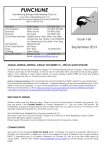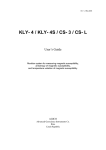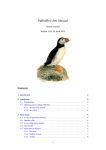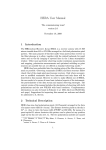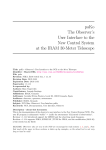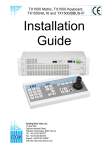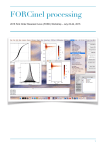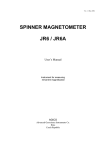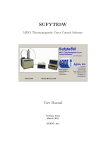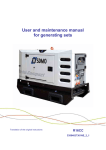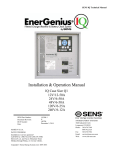Download LDA5/PAM1 User Manual
Transcript
LDA5/PAM1 Alternating Field Demagnetizer Anhysteretic and Pulse Magnetizer User Manual Version 1.2.0 October 2013 AGICO, Inc. LDA5/PAM1 – User Manual Agico, Inc. User Manual Conventions Prohibition symbol is used to prohibit any action which may cause a loss of properties, damage or injury. Warning symbol is used to draw a special attention to an important information. Information symbol is used to give a useful hint or tip for more confortable work with the instrument. LDA5 Software Conventions AC amplitude Fast START STOP [F1] [Enter] User interface terms. (Default values are underlined.) User interface buttons. Keyboard shortcuts. (Applicable only in the Desktop mode) Status Bar Indicators Green Instrument is ready. Orange Instrument in action. Blinking orange Demagnetization/Magnetization in process. Red Error or User stop. iii LDA5/PAM1 – User Manual Agico, Inc. General Safety Instructions Before beginning of work with the instrument review the following safety precautions to avoid injury and prevent damage to this product or any products connected to it. Only qualified personnel should perform service procedures! Do Not Operate Without Covers! To avoid electric shock or fire hazard, do not operate this product with covers or panels removed. Do Not Operate in Wet or Damp Conditions! To avoid electric shock, do not operate this product in wet or damp conditions. Do Not Operate in an Explosive Atmosphere! To avoid injury or fire hazard, do not operate this product in an explosive atmosphere. Do Not Disconnect Connectors! To avoid damage of the instrument never disconnect any connector while the device is ON. Do Not Operate With Suspected Failures! If you suspect there is damage to this product, have it inspected by qualified service personnel. Do Not Lift the Specimen Unit by the Top-Side Metal Rods! It should be handled only using two blue handgrips at each side of the unit. Use Proper Power Cord! To avoid fire hazard, use only the power cord specified for this product. Fasten Connectors! Do not operate the instrument if all connectors are not properly plugged and fixed by screws. Disconnect Power Source! To avoid risk of electric shock unplug the instrument from mains before reinstalling or removing unit. Use Proper Power Source! Do not operate this product from a power source that applies more than the voltage specified. iv LDA5/PAM1 – User Manual Agico, Inc. Use Proper Fuses Only! Do not use fuses which are not specified by the manufacturer. If a fuse with a different characteristics or value is used, the protection is not effective. The Instrument Parts Are Very Heavy! Be careful especially when handling the Specimen Unit. Operator’s Training! Operator should be familiar with operation of the instrument and Safety Regulations. Use Manufacturer’s Cables Only! Other devices can be connected to the instrument via the appropriate cables only. Avoid tumbling empty tumbler! If doing so, e.g. for the purpose of testing or instrument demonstration, make sure that the fixing screw is tighten. Loose screw may halt the tumbling motion and demage the tumbler. Unstable or highly disturbed AC power may invoke safety circuits to protect the sensitive electronic parts by switching OFF the instrument or burning inner fuses. Storage and Transportation The properly wrapped instrument can be stored and transported at a temperature -20 ◦ C to + 55 ◦ C and relative humidity up to 80 %. The instrument must be stored at suitable place, free of dust and chemical evaporation. v LDA5/PAM1 – User Manual Agico, Inc. Contents 1 Introduction 1 2 Operational Principle 2.1 Demagnetizer . . . . . . . . . . . . . . . . . . . . . . . . . . . 2.2 Anhysteretic Magnetizer . . . . . . . . . . . . . . . . . . . . . 2.3 Pulse Magnetizer . . . . . . . . . . . . . . . . . . . . . . . . . 3 3 4 4 3 Instrument Set-Up 7 4 Computer Control 10 4.1 Software Installation . . . . . . . . . . . . . . . . . . . . . . . 10 4.2 Uninstalling of Software . . . . . . . . . . . . . . . . . . . . . 10 5 Working with the Instrument 5.1 Starting the Instrument . . . . . . . . . . . 5.2 Selecting Instrument Mode . . . . . . . . . . 5.3 Demagnetization . . . . . . . . . . . . . . . 5.3.1 Setting Demagnetization Parameters 5.3.2 Demagnetization Process . . . . . . . 5.4 Anhysteretic Magnetization . . . . . . . . . 5.4.1 Setting Magnetization Parameters . . 5.4.2 Magnetization Process . . . . . . . . 5.5 Pulse Magnetization . . . . . . . . . . . . . 5.5.1 Setting Magnetization Parameters . . 5.5.2 Magnetization Process . . . . . . . . . . . . . . . . . . . 12 12 13 14 14 17 20 20 22 24 24 25 6 Appendix 6.1 Technical Specifications . . . . . . . . . . . . . . . . . . . . . . 6.2 Warranty . . . . . . . . . . . . . . . . . . . . . . . . . . . . . 6.3 EC Declaration of Conformity . . . . . . . . . . . . . . . . . . 27 27 28 29 vii . . . . . . . . . . . . . . . . . . . . . . . . . . . . . . . . . . . . . . . . . . . . . . . . . . . . . . . . . . . . . . . . . . . . . . . . . . . . . . . . . . . . . . . . . . . . . . . . . . . LDA5/PAM1 – User Manual 1 Agico, Inc. Introduction LDA5 – Laboratory Demagnetizer using Alternating field serves for a laboratory demagnetization of rock or soil samples. Alternating field demagnetization is one of the principal techniques used in paleomagnetism to isolate the characteristic component(s) of the natural remanent magnetization. In rock magnetic research, alternating field demagnetization is used for magnetic cleaning, namely to remove any laboratory-imparted magnetization resulting from rock magnetic experiments. PAM1 – Pulse and Anhysteretic Magnetizer (optional electronic add-on unit to LDA5 Demagnetizer) serves for a deliberate anhysteretic or (low-field) isothermal magnetization of rock or soil samples. A controlled acquisition of remanent magnetization (either ARM or IRM) is used, for example, to estimate absolute paleointensity, characterize magnetic carriers of rocks, determine their domain state and grain sizes, detect magnetic fabric, or study any other fundamental aspects of magnetism. 1 LDA5/PAM1 – User Manual Agico, Inc. 2 LDA5/PAM1 – User Manual 2 2.1 Agico, Inc. Operational Principle Demagnetizer Alternating field demagnetization is performed by exposing a specimen to an alternating magnetic field (AC field) of gradually decreasing amplitude in a null magnetic field environment (Figure 1a). The peak AC field amplitude (ACmax ) controls which part of the specimen coercivity spectrum is involved in the demagnetization process. Assuming a range of coercivities in a specimen, domains with coercivities equal to or lower than ACmax follow the field oscillation. As the field amplitude is gradually decreased, each domain is remagnetized when the field passes its coercivity value. Two opposite senses of the AC field represent two preferential directions, and when AC field amplitude gets to zero, domain magnetization is statistically distributed half in one sense, half in the opposite, thereby yielding a zero resultant magnetization. During a demagnetization treatment, the AC field amplitude is: (1) increased to its peak value as quickly as possible (special care is taken not to overshoot the peak value), (2) maintained constant for a desired time (ACmax plateau), and then (3) gradually decreased to zero. There are four options for the decrease rate and three options for the course of decrease (Figure 7). During the entire process, the specimen is subjected to a slow motion in the two-axis tumbler to allow the demagnetization in all possible directions. Alternatively, the specimen can be demagnetized parallel to one of its coordinate system axis or, in the three-axis mode, subsequently parallel to all three axes. The whole demagnetization process is computer-controlled and fully automated. The usual strategy of alternating field demagnetization is to repeat the above-described process in several steps, each time with increasing ACmax , and thus gradually erase remanence components of increasing coercivity. After each step, the magnetic remanence should be measured and visualized to monitor the whole process. The actual demagnetization using LDA5 is performed in the Specimen Unit equipped with a solenoid (coil) shielded from the external magnetic field (mainly Earth’s magnetic field) by three layers of mu-metal. The coil carries an alternating current which induces an alternating magnetic field that is, in a certain volume inside the coil, parallel to its axis. The electric current is generated in such a way that it is free of the higher harmonic frequencies that may cause an undesired parasitic magnetization. 3 LDA5/PAM1 – User Manual 2.2 Agico, Inc. Anhysteretic Magnetizer Anhysteretic remanent magnetization (ARM) is acquired when a specimen is subjected to an AC field of gradually decreasing amplitude simultaneously with a steady DC field (also referred to as a bias field). The combined action of AC and DC fields is much more efficient in producing a remanence than the application of a DC field alone. AC field amplitude controls which particles, based on their coercivity, are involved in the magnetization process while DC field intensity controls how much the particles in question are magnetized. Typically, the DC field is maintained during the entire course of AC field decrease (Figure 1b). In a special case, a DC field is applied only for a limited time within an AC coercivity window ACmax and ACmin , to acquire a partial ARM (pARM, Figure 1c). The actual magnetization using LDA5/PAM1 is performed in the Specimen Unit. DC field is parallel to the coil axis and points out of the coil. The two-axis tumbler facilitates specimen positioning into 18 different orientations (with respect to the coil axis) and hence a directional ARM acquisition (Figure 2). Optionally, the directional acquisition can be subsequently performed following a scheme of directions to calculate anisotropy of anhysteretic remanent magnetization (AARM). 2.3 Pulse Magnetizer Isothermal remanent magnetization (IRM) is usually understood as a remanence resulting from the application of a DC field to an assemblage of magnetic particles. Using the Pulse Magnetizer, IRM is imparted by subjecting a specimen to a pulse of DC field of certain intensity, duration, and polarity, or optionally, a sequence of pulses of alternating polarity (Figure 1d). The actual magnetization using LDA5/PAM1 is performed in the Specimen Unit. DC field is parallel to the coil axis and points out of the coil. The two-axis tumbler facilitates specimen positioning into 18 different orientations and hence a directional IRM acquisition (Figure 2). Optionally, the directional acquisition can be subsequently performed following a scheme of directions to calculate anisotropy of isothermal remanent magnetization (AIRM). 4 LDA5/PAM1 – User Manual a) ACmax Agico, Inc. b) AF Demagnetization Anhysteretic Magnetization ACmax AC field 0 AC field DC field 0 Time [a.u.] Time [a.u.] c) ACmax d) Partial Anhysteretic Magnetization Pulse Magnetization DC field AC field DC field ACmin +DC + 0 + 0 - - -DC Time [a.u.] Time [a.u.] Figure 1: Schematic principles of demagnetization or magnetization. a) Alternating field demagnetization – particles with coercivity equal to or lower than ACmax are demagnetized. b) Anhysteretic magnetization – particles with coercivity equal to or lower than ACmax are magnetized. c) Partial anhysteretic magnetization – only particles within the coercivity window between ACmax and ACmin are magnetized. d) Pulse magnetization – example of four DC field pulses with alternating polarity. 5 LDA5/PAM1 – User Manual Agico, Inc. +X U1 U7 U9 U15 U18 U5 U14 U4 U12 U6 U11 U3 U13 P17 P16 U10 U8 U2 Lower hemisphere Upper hemisphere Figure 2: Spherical projection of 18 magnetizing directions (User mode). 6 LDA5/PAM1 – User Manual 3 Agico, Inc. Instrument Set-Up The instrument consists of the following units (Figure 3): • Specimen Unit – a large glossy tube equipped with a demagnetizing/magnetizing coil located inside of three mu-metal shielding. Inside of the coil, and parallel to its axis, there is a specimen holder equipped with a two-axis tumbler system, further refer to as the tumbler. The tumbler is attached to a rail and can be pulled out the Specimen Unit in order to mount the specimen. • LDA5 Unit – controls demagnetization process as well as the tumbler motion. • PAM1 Unit – an optional add-on unit. It controls the generation of DC fields used for anhysteretic or pulse magnetizations. • PC Computer – controls the instrument via a USB cable. Figure 3: A typical set-up of LDA5/PAM1 showing individual units of the instrument. 7 LDA5/PAM1 – User Manual Agico, Inc. The instrument is transported as unconnected units that are carefully packed in order to be protected as much as possible from any transportationrelated damage. To assemble the instrument follow these steps: 1. Remove carefully all units and instrument accessories from the transportation box and unwrap the packing material. Refer to the Packing List to verify that everything has been delivered. Briefly inspect each item for shipping damage. If anything is missing or damaged, contact the manufacturer or your dealer immediately. 2. Place the individual units on a solid (preferably wooden) table. For the maximum shielding effect, the Specimen Unit should be oriented, using a compass, with its cylinder axis perpendicular to the local magnetic meridian, i.e. its axis should be oriented W-E. It is recommended to draw a W-E line on the table before installing the Specimen Unit because a close contact of the compass with the mu-metal shield could cause a compass deviation and thus an imprecise orientation. LDA5 Unit, and optionally PAM1 Unit, are recommended to be placed on the table next to the Specimen Unit (see Figure 3 for an example set-up). 3. Connect the individual units using the interconnecting cables (Figure 4). The cables have different connectors so any misconnection is impossible. PC Computer (Desktop/Notebook/Tablet) is connected to the LDA5 Unit via USB cable (provided with the instrument). LDA5 program must be installed before the USB cable is connected to the computer!1 LDA5 Unit, and optionally PAM1 Unit, are connected to the power outlet via a surge protector. Never lift the Specimen Unit by the top-side metal rods! It should be handled only using two blue handgrips at each side of the unit or the metal base frame. The instrument parts are very heavy! Be careful especially when handling the Specimen Unit. You may retain the transportation box and other packing material in case you need to ship the instrument. 1 For LDA5 installation see Chapter 4.1. 8 PC Computer Agico, Inc. Surge protector to AC power outlet special power connector 37 pin Coil Tumbler fix cable fix cable 15 pin AC power LDA5 LDA5 Unit 15 pin AC power USB PAM1 USB AC power LDA5/PAM1 – User Manual PAM1 Unit (optional) 25 pin Coil DC connect 25 pin Specimen Unit Figure 4: LDA5/PAM1 interconnecting scheme. 9 LDA5/PAM1 – User Manual 4 Agico, Inc. Computer Control The instrument is controlled by the LDA5 program running on a PC Desktop or Tablet with MS Windows Operating System (Windows 98 up to Windows 8 ). If the instrument is delivered with a computer, a copy of LDA5 is already installed. If not, you must install the software according to the following instructions. 4.1 Software Installation The installation is very straightforward and consists of several easy steps. You can navigate forward or backward by clicking on Next > or < Back , respectively. 1. Double-click on LDA5-Setup.exe to start the LDA5 Setup Wizard (Figure 5a). 2. Select whether you install the software on Desktop or Tablet (Figure 5b). 3. Select the installation directory (Figure 5c). It is recommended to keep the default directory (C:\Agico\LDA5) as pre-set by the installation wizard. 4. Choose the folder name in the Start menu (Figure 5d). 5. Indicate whether you want to create a desktop icon (Figure 5e). 6. Revise your installation settings and start the installation by clicking on Install (Figure 5f). 7. Revise the installation report (Figure 5g). 8. Finish the installation by clicking on Finish (Figure 5h). 4.2 Uninstalling of Software To remove LDA5 from your computer, select the Uninstall LDA5 item in the Start|Programs|LDA5 menu option. All application files, desktop icons, and shortcuts will be deleted. 10 LDA5/PAM1 – User Manual Agico, Inc. a) b) c) d) e) f) g) h) Figure 5: Installation steps of LDA5 program. 11 LDA5/PAM1 – User Manual 5 Agico, Inc. Working with the Instrument 5.1 Starting the Instrument 1. Make sure that the LDA5 program is correctly installed (see Chapter 4.1)! 2. Connect the instrument to the computer via the USB cable. A new virtual COM-Port is automatically assigned. Wait several seconds to complete this action until a notification appears. 3. Switch ON the LDA5 Unit, and optionally, the PAM1 Unit. The main power switch is located on the rear side of the respective unit. 4. Start LDA5 by double-clicking on LDA5 desktop icon or by clicking on the LDA5 item in the Start|Programs|LDA5 menu of the operating system. 5. The software automatically: (a) Searches for the instrument connection via USB. If no connection is found, check whether the instrument is ON or properly connected.2 (b) Searches for the optimal frequency of AC current used for AC field generation. The optimal frequency should be around 43 Hz. This step is done only once a month. (c) Initializes the tumbler. 6. x instrument is ready status bar message indicates a successfull instrument initialization. LDA5 Unit cannot be switched ON right after it has been switched OFF. You must wait 10 s before restarting the instrument. Even though the PAM1 Unit has its own main power switch, its switching is controlled by the LDA5 Unit. You may leave the PAM1 Unit ON all the time. To get an interactive hint hover the mouse pointer over the desired item of the user interface (without clicking it) and a tooltip box appears. Note that Tooltips do not appear in the Tablet mode. 2 Only the virtual ports COM1 to COM16 are scanned. If the connection is not found check whether the assigned COM port is in the range COM1-COM16 using the Windows device manager. 12 LDA5/PAM1 – User Manual 5.2 Agico, Inc. Selecting Instrument Mode Depending on the hardware configuration, the following instrument modes are available. Click on the respective button to switch the instrument into the desired mode: [F1] – see Section 5.3 DEMAGNETIZER 3 ANHYSTERETIC MAGNETIZER 3 [F2] – see Section 5.4 PULSE MAGNETIZER 3 [F3] – see Section 5.5 Available only when the PAM1 Unit is connected. 13 LDA5/PAM1 – User Manual 5.3 5.3.1 Agico, Inc. Demagnetization Setting Demagnetization Parameters Switch the instrument into the DEMAGNETIZER mode (Section 5.2) and set the desired demagnetization parameters (Figure 6): AC amplitude – maximum amplitude of AC field (0 – 200 mT)4 AC max time – duration of AC field plateau (0 – 30 s) AC decrease rate5 ◦ Slow – decrease rate ca. 1 mT/s (0 – 100 mT) ◦ Medium – decrease rate ca. 1.5 mT/s (0 – 150 mT) • Fast – decrease rate ca. 3 mT/s (0 – 200 mT) ◦ Extra fast – decrease rate ca. 9 mT/s (0 – 200 mT) AC decrease course ◦ Speeding – gentle decrease of AC amplitude at start and steep in the end (Figure 7a) • Linear– linear decrease of AC amplitude (Figure 7b) ◦ Slowing – steep decrease of AC amplitude at start and gentle in the end (Figure 7c) √ Tumbler – if checked, the tumbler is active and the following options are applicable: • Tumbling specimen – demagnetization of tumbling specimen ◦ Three axes – subsequent demagnetization parallel to all three specimen axes ◦ +x-axis – demagnetization with the +x-axis facing out of the coil ◦ +y-axis – demagnetization with the +y-axis facing out of the coil ◦ +z-axis – demagnetization with the +z-axis facing out of the coil ◦ –x-axis – demagnetization with the −x-axis facing out of the coil ◦ –y-axis – demagnetization with the −y-axis facing out of the coil ◦ –z-axis – demagnetization with the −z-axis facing out of the coil 14 LDA5/PAM1 – User Manual Agico, Inc. Figure 6: An example of the DEMAGNETIZER user interface in the Desktop or Tablet installation modes. 4 See AC decrease rate for the maximum AC amplitude available for each rate. For approximate duration of a single demagnetization treatment see Table 1 on Page 16. 5 15 LDA5/PAM1 – User Manual Agico, Inc. Table 1: Approximate durations of a single demagnetization/anhysteretic magnetization treatment according to the maximum AC field amplitude and AC decrease rate. Note that the presented values do not include duration of tumbler manipulations and AC max plateau. Medium 19 s 25 s 43 s 74 s 108 s n/a Speeding b) AC amplitude [a.u.] a) Slow 22 s 31 s 58 s 105 s n/a n/a Fast 16 s 19 s 29 s 44 s 64 s 80 s Extra fast 14 s 16 s 19 s 24 s 35 s 41 s Linear AC amplitude [a.u.] AC max 10 mT 20 mT 50 mT 100 mT 150 mT 200 mT Time [a.u.] Time [a.u.] Slowing AC amplitude [a.u.] c) Time [a.u.] Figure 7: AC field amplitude during a single demagnetization treatment. Blue – AC field increase, Green – AC max plateau, Red – AC field decrease with three different courses: a) Speeding decrease, b) Linear decrease, c) Slowing descrease. 16 LDA5/PAM1 – User Manual 5.3.2 Agico, Inc. Demagnetization Process 1. Pull the tumbler from the Specimen Unit. 2. Insert the specimen into the tumbler (Figure 8). The front face of the specimen must be oriented toward the coil and the arrow representing the x-axis of the specimen coordinate system (Figure 9) must point upward. 3. Gently tighten the fixing screw (Figure 8). Be careful, excessive tightening force may temporarily skew the tumbler which may leads to its malfunction. 4. Push the tumbler all the way into the Specien Unit. 5. Hit START [Enter]. 6. According to the Demagnetization mode, the tumbling motion starts or the required specimen orientation is set. 7. AC field is quickly increased to its maximum amplitude, ACmax , maintained constant for a desired time, and then gradually decreased to zero (Figure 7). The current AC field amplitude is displayed in the RED panel of the user interface (Figure 6). 8. In the Three axes mode, the Steps 6 and 7 are repeated for each specimen axis. 9. The tumbler is initialized. 10. a instrument is ready status bar mesage indicates that the instrument is ready for the next action. In case of emergency (e.g. specimen gets loose), demagnetization process can be immediately stopped by clicking on STOP [Space Bar]. Tumbling motion is immediately stopped and AC field amplitude drops to zero as fast as possible. To initialize the tumbler, hit INITIALIZE TUMBLER [Key I]. 17 LDA5/PAM1 – User Manual a) Agico, Inc. b) Tumbler handle Tow ard Tumbler handle Tow ard the coil the coil Fixing screw Fixing screw Figure 8: Specimen mounting into the tumbler. The front face of the specimen must be oriented toward the coil and the arrow representing the x-axis of the specimen coordinate system (red) must point upward. a) Cylindric specimen, b) Cubic specimen. z z y y x x Figure 9: Specimen marking convention for cylindric and cubic specimens, right-handed coordinate system. Single arrow represents the x-axis of the specimen. 18 LDA5/PAM1 – User Manual Agico, Inc. To prevent an excessive overheating of the instrument amplifier, especially when higher AC fields with longer AC max plateau times are used, the software may wait for a short time before new demagnetization treatment is allowed to start. Long-term use of higher AC fields causes a gradual heating of the Specimen Unit coil. Heat dissipation is aided by cooling fans that are automatically activated when AC amplitude higher then 50 mT is set. 19 LDA5/PAM1 – User Manual 5.4 5.4.1 Agico, Inc. Anhysteretic Magnetization Setting Magnetization Parameters Switch the instrument into the ANHYSTERETIC MAGNETIZER mode (Section 5.2) and set the desired magnetization parameters (Figure 11): AC/DC fields AC max – maximum amplitude of AC field (0 – 200 mT)6 AC min – amplitude of AC field at which DC field is switched OFF (0 – AC max) DC – intensity of DC field (0 – 500 µT) AC max time – duration of AC max plateau (0 – 30 s) AC decrease rate7 ◦ Slow – decrease rate ca. 1 mT/s (0 – 100 mT) ◦ Medium – decrease rate ca. 1.5 mT/s (0 – 150 mT) • Fast – decrease rate ca. 3 mT/s (0 – 200 mT) ◦ Extra fast – decrease rate ca. 9 mT/s (0 – 200 mT) AC decrease course ◦ Speeding – gentle decrease of AC amplitude at start and steep in the end (Figure 7a) • Linear– linear decrease of AC amplitude (Figure 7b) ◦ Slowing – steep decrease of AC amplitude at start and gentle in the end (Figure 7c) √ Tumbler – if checked, the tumbler is active and the following options are applicable: • User mode – all available 18 directions ◦ A-mode – anisotropy A-mode (12 directions) ◦ B-mode – anisotropy B-mode (6 directions) 6 See AC decrease rate for the maximum AC amplitude available for each rate. For approximate duration of a single demagnetization treatment see Table 1 on Page 16. 7 20 LDA5/PAM1 – User Manual Agico, Inc. Figure 10: An example of the ANHYSTERETIC MAGNETIZER user interface in the Desktop or Tablet installation modes. ◦ C-mode – anisotropy C-mode (6 directions) ◦ D-mode – anisotropy D-mode (3 directions) ◦ P-mode – anisotropy P-mode (15 directions) ◦ +x-axis – magnetization parallel to the +x-axis ◦ +y-axis – magnetization parallel to the +y-axis ◦ +z-axis – magnetization parallel to the +z-axis ◦ –x-axis – magnetization parallel to the −x-axis ◦ –y-axis – magnetization parallel to the −y-axis ◦ –z-axis – magnetization parallel to the −z-axis 21 LDA5/PAM1 – User Manual Agico, Inc. PREV 8 – previous magnetizing direction is set [PgUp] . √ NEXT 8 – next magnetizing direction is set [PgDn]. Auto next8 – if checked, a subsequent magnetizating direction is automatically set when the current magnetization is finished. Table 2: A scheme of magnetizing directions according to the magnetizing mode. Directions are presented in specimen coordinate system as declination / inclination. Each pair represents a set of antipodal directions. User mode U1 U2 U3 U4 U5 U6 U7 U8 U9 U10 U11 U12 U13 U14 U15 U16 U17 U18 5.4.2 Principal axes +x-axis –x-axis +y-axis –y-axis +z-axis –z-axis A-mode A1 A2 A3 A4 A5 A6 A7 A8 A9 A10 A11 A12 B-mode C-mode D-mode P-mode Direction C1 C2 C3 C4 C5 C6 D1 P3 D2 P8 D3 P13 0/0 180/0 90/0 270/0 0/90 0/–90 45/0 225/0 315/0 135/0 90/45 270/–45 90/–45 270/45 0/45 180/–45 180/45 0/–45 B1 P2 P5 P4 P1 P7 P10 P9 P6 P12 P15 P14 P11 B2 B3 B4 B5 B6 Magnetization Process 1. Pull the tumbler from the Specimen Unit. 2. Insert the specimen into the tumbler (Figure 8). The front face of the specimen must be oriented toward the coil and the arrow representing the x-axis of the specimen coordinate system (Figure 9) must point upward. 3. Gently tighten the fixing screw (Figure 8). Be careful, excessive tightening force may temporarily skew the tumbler which may leads to its malfunction. 8 Available only for Anisotropy modes. 22 LDA5/PAM1 – User Manual Agico, Inc. 4. Push the tumbler all the way into the Specien Unit until you feel a slight click. 5. Hit START [Enter]. 6. The tumbler sets the required specimen orientation (according to the Magnetizing mode). 7. DC field is switched ON9 . 8. AC field is increased to its maximum amplitude, ACmax , maintained constant for a desired time, and then gradually decreased to zero (Figure 7). The current AC field amplitude is displayed in the RED panel and the current DC field intensity in the GREEN panel of the user interface (Figure 11). 9. DC field is switched OFF. Alternatively, when performing a partial anhysteretic magnetization, DC field is switched OFF during the AC field decrease (Step 8) when AC field amplitude drops below ACmin . 10. The tumbler is initialized. 11. a instrument is ready status bar mesage indicates that the instrument is ready for the next action. In case of emergency (e.g. specimen gets loose), magnetizing process can be immediately stopped by clicking on STOP [Space Bar]. AC field amplitude and DC field intensity drop to zero as fast as possible. To initialize the tumbler, hit INITIALIZE TUMBLER [Key I]. 9 DC field vector points out of the coil. 23 LDA5/PAM1 – User Manual 5.5 Agico, Inc. Pulse Magnetization 5.5.1 Setting Magnetization Parameters Switch the instrument into the PULSE MAGNETIZER mode (Section 5.2) and set the desired magnetization parameters (Figure ??): Pulse intensity – intensity of DC field pulse (0 – 20 mT) Pulse time – duration of DC field pulse (0.1 – 10 s; for the shortest pulse, 0.01 s, enter 0) Pulses10 – number of DC pulses with alternating polarity (1 – 10) √ Tumbler – if checked, the tumbler is active and the following options are applicable: • User mode – all available 18 directions ◦ A-mode – anisotropy A-mode (12 directions) ◦ B-mode – anisotropy B-mode (6 directions) ◦ C-mode – anisotropy C-mode (6 directions) ◦ D-mode – anisotropy D-mode (3 directions) ◦ P-mode – anisotropy P-mode (15 directions) ◦ +x-axis – magnetization parallel to the +x-axis ◦ +y-axis – magnetization parallel to the +y-axis ◦ +z-axis – magnetization parallel to the +z-axis ◦ –x-axis – magnetization parallel to the −x-axis ◦ –y-axis – magnetization parallel to the −y-axis ◦ –z-axis – magnetization parallel to the −z-axis PREV 11 – previous magnetizing direction is set [PgUp] . √ 10 11 NEXT 11 – next magnetizing direction is set [PgDn]. Auto next11 – if checked, a subsequent magnetizating direction is automatically set when the current magnetization is finished. Not available when Pulse time is longer than 1 s. Available only for Anisotropy modes. 24 LDA5/PAM1 – User Manual Agico, Inc. Figure 11: An example of the PULSE MAGNETIZER user interface in the Desktop or Tablet installation modes. 5.5.2 Magnetization Process 1. Pull the tumbler from the Specimen Unit. 2. Insert the specimen into the tumbler (Figure 8). The front face of the specimen must be oriented toward the coil and the arrow representing the x-axis of the specimen coordinate system (Figure 9) must point upward. 3. Gently tighten the fixing screw (Figure 8). Be careful, excessive tightening force may temporarily skew the tumbler which may leads to its malfunction. 25 LDA5/PAM1 – User Manual Agico, Inc. 4. Push the tumbler all the way into the Specien Unit. 5. Hit START [Enter]. 6. The tumbler sets the required specimen orientation (according to the Magnetizing mode). 7. The DC field is swiched ON12 . The current DC field intensity is shown in the GREEN panel of the user interface (Figure 11). 8. After a desired pulse time the DC field is swiched OFF. 9. If the number of Pulses is higher than 1, the Steps 7 and 8 are repeated for a required number of times, each time with a pulse of alternating polarity. 10. The tumbler is initialized. 11. a instrument is ready status bar mesage indicates that the instrument is ready for the next action. In case of emergency (e.g. specimen gets loose), magnetizing process can be immediately stopped by clicking on STOP [Space Bar]. DC field intensity drops to zero as fast as possible. To initialize the tumbler, hit INITIALIZE TUMBLER [Key I]. 12 DC field vector points out of the coil. 26 LDA5/PAM1 – User Manual 6 Agico, Inc. Appendix 6.1 Technical Specifications LDA5 PC connection USB port (galvanically isolated from the PC) Specimen dimensions Cube: 23.5 × 23.5 × 23.5 mm Cube: 20.0 × 20.0 × 20.0 mm (with adapter) Cylinder: 25.4 diameter, 23.5 mm height AC field 0 to 200 mT (peak value) Power requirements 230 V / 50 Hz, 1600 VA max (optionally 115 V / 60 Hz) Main fuses 2 × 10 A (for 115 V: 2 × 20 A), T – Time-lag type Dimensions, Mass Specimen Unit: 110 × 39 × 46 cm, 95 kg Electronic Unit: 47 × 38 × 17 cm, 30 kg PAM1 DC field 0 to 500 µT (Anhysteretic Magnetizer) 1 to 20 mT (Pulse Magnetizer) Duration of DC pulse 0.01 to 10 s (Pulse Magnetizer) Power requirements 230 V / 50 Hz, 100 VA max (optionally 115 V / 60 Hz) Main fuses 2 × 2 A (for 115 V: 2 × 4 A), T – Time-lag type Dimensions, Mass Electronic Unit: 47 × 38 × 13 cm, 20 kg 27 LDA5/PAM1 – User Manual 6.2 Agico, Inc. Warranty AGICO warrants that this product will be free from defects in materials and workmanship for a period of usually 1 (one) year from date of installation. However, if the installation is performed later than 3 (three) months after the date of shipment due to causes on side of Customer, the warranty period begins three months after the date of shipment. If any such product proves defective during this warranty period, AGICO, at its option, either will repair the defective product without charge for parts and labour, or will provide a replacement in exchange for the defective product. In order to obtain service under this warranty, Customer must notify AGICO of the defect before the expiration of the warranty period and make suitable arrangements for the performance of service. AGICO will decide if the repair is to be performed by AGICO technician or AGICO delegated serviceman in customers laboratory, or product shall be sent for repair to the manufacturer. In latter case, customer shall be responsible for packaging and shipping the defective product to the AGICO service centre. In both cases, all the costs related to a warranty repair shall be at expenses of AGICO. The warranty becomes invalid if the Customer modifies the instrument or fails to follow the operating instructions, in case of failure caused by improper use or improper or inadequate maintenance and care, or if the Customer attempts to install the instrument without explicit written permission of AGICO company. AGICO shall not be obligated to furnish service under this warranty a) to repair damage resulting from attempts by personnel other than AGICO representatives to install, repair or service the product; b) to repair damage resulting from improper use or connection to incompatible equipment; or c) to service a product that has been modified or integrated with other products when the effect of such modification increases the time or difficulty of servicing the product. This warranty is given by AGICO with respect to this product in lieu of any other warranties, expressed or implied. AGICO and its vendors disclaim any implied warranties of merchantability or fitness for a particular purpose. AGICO’s responsibility to repair or replace defective products is the sole and exclusive remedy provided to the Customer for breach of this warranty. AGICO and its vendors will not be liable for any indirect, special, incidental, or consequential damages irrespective of whether AGICO or vendor has advance notice of the possibility of such damages. 28 LDA5/PAM1 – User Manual 6.3 Agico, Inc. EC Declaration of Conformity We, AGICO, s.r.o., Ječná 29a, CZ - 621 00 Brno, IČO 607 313 54, declare that the product: Name: System for alternating field demagnetization and anhysteretic/pulse magnetization of rock samples Modulus Type: LDA5 - Alternating Field Demagnetizer Modulus Type: PAM1 - Anhysteretic and Pulse Magnetizer Manufacturer: AGICO, s.r.o., Ječná 29a, CZ - 621 00 Brno, IČO 607 313 54 Place of producing: AGICO, s.r.o., Ječná 29a, CZ - 621 00 Brno, IČO 607 313 54 fulfils the applicable requirements of following regulations / normative documents and technical specifications: ČSN EN 61000-6-3 ed. 2:2007+A1:2011 – (Czech version EN 61000-6-3:2007+A1:2011) ČSN EN 55016-2-1 ed. 3:2009+A1:2011 – (Czech version EN 55016-2-1:2010+A1:2011) ČSN EN 55016-2-3 ed. 3:2010+A1:2011 – (Czech version EN 55016-2-3:2010+A1:2010) ČSN EN 61000-3-2 ed. 3:2006+A1:2010+A2:2010 – (Czech version EN 61000-3-2:2006+A1:2009+A2:2009) ČSN EN 61000-3-3 ed. 2:2009 – (Czech version EN 61000-3-3:2008) ČSN EN 61000-6-1 ed. 2:2007 – (Czech version EN 61000-6-1:2005) ČSN EN 61000-4-2 ed. 2:2009 – (Czech version EN 61000-4-2:2009) ČSN EN 61000-4-3 ed. 3:2006+A1:2008+A2:2011 – (Czech version EN 61000-4-3:2006+A1:2007+A2:2010) ČSN EN 61000-4-4 ed. 2:2005+A1:2010 – (Czech version EN 61000-4-4:2004+A1:2010) ČSN EN 61000-4-5 ed. 2:2007 – (Czech version EN 61000-4-5:2006) ČSN EN 61000-4-6 ed. 3:2009 – (Czech version EN 61000-4-6:2009) ČSN EN 61000-4-11 ed. 2:2005 – (Czech version EN 61000-4-11:2004) The judgement of conformity was performed in co-operation with the TÜV SÜD Czech s.r.o., Prague, Czech Republic Place and date of issue: Brno, May 2013 Responsible person: Petr Pokorný, development engineer 29











































